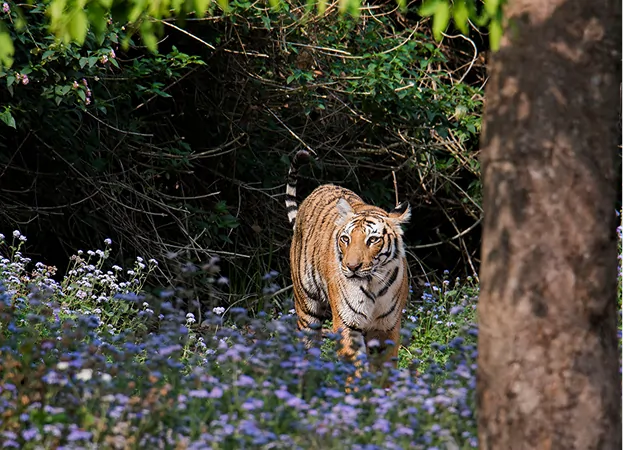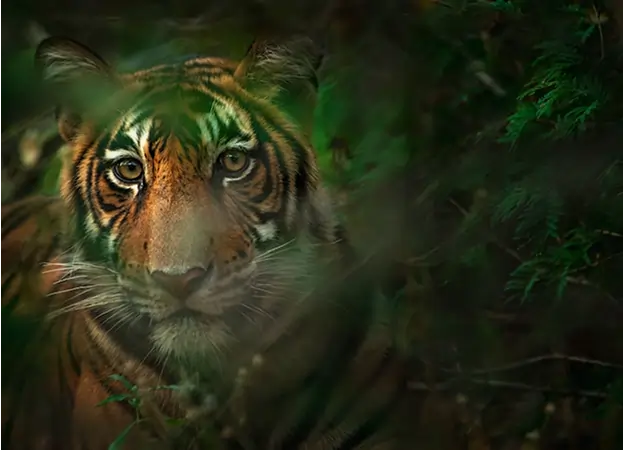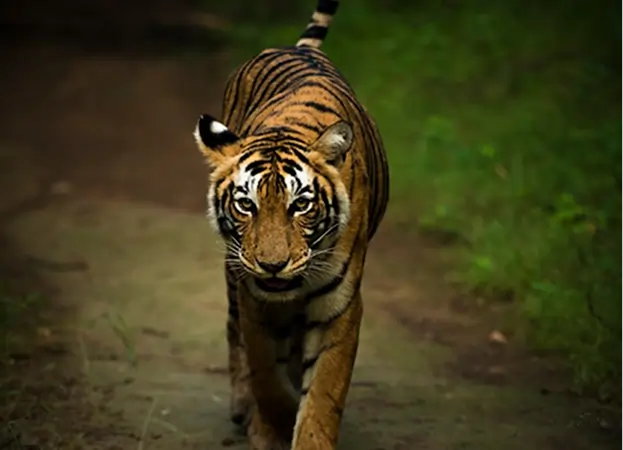The Ultimate Step-by-Step Guide to Tiger Safari India
Few travel experiences compare to the thrill of coming face-to-face with a wild tiger in its natural habitat. A tiger safari India is more than just a wildlife tour—it’s an immersive journey into the raw beauty of the Indian wilderness, where nature rules and every trail holds a story.
India is home to over 70% of the world’s wild tiger population, India is undeniably the top destination to witness these majestic big cats. From the lush sal forests of Kanha and Bandhavgarh to the dry grasslands of Ranthambhore and the mangrove swamps of Sundarbans, each park offers a distinct and unforgettable setting for a tiger safari India.
However, planning your first – or even second – safari can be overwhelming. With numerous national parks, safari zones, travel seasons, and permit requirements, it’s easy to feel unsure about where to begin.
That’s why we’ve put together this step-by-step guide to booking a tiger safari India. It covers everything from selecting the ideal park and best time to visit to securing your permits, choosing the right accommodations, and getting the most from your wildlife experience.
If spotting the Royal Bengal Tiger in the wild is on your bucket list, this guide will help you make it happen the right way.
Let’s begin—your jungle adventure awaits!
Step 1: Choose the Right Tiger Reserve
India is home to 58 tiger reserves, each offering a unique wilderness experience. Choosing the right reserve is essential, as it influences everything—from your chances of spotting a tiger to the type of landscape you’ll explore, the overall safari quality, and how remote or busy the journey feels.
Below are some of the top tiger reserves known for delivering exceptional safari experiences:
Kanha Tiger Reserve – Madhya Pradesh
- Why choose Kanha: A breathtaking expanse of Sal forests, meadows, and hills, Kanha is among the most scenic parks in India and a model for conservation.
- Wildlife highlight: The last stronghold of the endangered hard ground Barasingha.
- Tiger experience: Consistently good sightings, especially in Mukki and Kanha zones. Tigers here are well habituated to vehicles, offering great photo ops.
- Bonus: Excellent Park infrastructure and eco-tourism practices.
Bandhavgarh Tiger Reserve – Madhya Pradesh
- Why choose Bandhavgarh: Compact in size but high in tiger density, Bandhavgarh is ideal for those seeking frequent and close tiger encounters.
- Landscape: Rugged cliffs, forested valleys, and the majestic Bandhavgarh Fort towering above.
- Tiger experience: Tigers are often seen in open meadows and trails, making it a favorite among photographers.
- Best for: Fast-paced safaris with high chances of sighting tigers.
Ranthambhore National Park – Rajasthan
- Why choose Ranthambhore: A historic and iconic park where tigers roam amidst ancient monuments, lakes, and ruins — a surreal blend of wildlife and heritage.
- Famous tigers: Home to the legendary Machli, considered one of the most photographed tigers in the world.
- Tiger experience: Tigers here are known for being bold and visible, often spotted in daylight and near water bodies.
- Accessibility: Easily reachable from Delhi and Jaipur, can be an extension of the Golden triangle tour.
Corbett Tiger Reserve – Uttarakhand
- Why choose Corbett: India’s first national park, offering rich biodiversity and a true jungle feel.
- Habitat: Lush riverine forests, grasslands, and foothills of the Himalayas — stunningly scenic and teeming with birdlife.
- Tiger experience: Sightings can be more elusive due to dense vegetation, but the thrill of tracking tigers here is unmatched. Some zones, like Dhikala are known for its tiger and elephant sightings in the famous Dhikala grasslands.
- Best for: Bird watchers, nature lovers, and those looking for a varied wildlife experience beyond just tigers.
Tadoba-Andhari Tiger Reserve – Maharashtra
- Why choose Tadoba: A rising star among Indian reserves, Tadoba is one of the best places to see tigers in India, with excellent sighting records year-round.
- Habitat: Dry deciduous forest with bamboo thickets, open grasslands, and waterholes — perfect tiger habitat.
- Tiger experience: Tigers, leopards, wild dogs, sloth bears, and more — often seen right by the safari tracks.
- Best for: Travelers who want less commercialized experiences, frequent sightings, and are open to warmer climates.
- Seasonal advantage: Open even during the monsoon (buffer zones), making it a unique choice for off-season safaris.
Final Tip for choosing tiger reserve for Tiger Safari India
When choosing your tiger reserve, consider:
- Sighting probability (Tadoba, Bandhavgarh, Kanha)
- Scenic diversity and landscape photography (Kanha, Corbett)
- Historic or cultural interest (Ranthambhore)
- Time of year, accessibility, and how remote or touristy you want the experience to be.
Once you’ve chosen your reserve, the next step is figuring out when to go. Timing can make or break your safari.
Step 2: Decide the Best Time to Visit
The success of your tiger safari India tour doesn’t just depend on where you go—when you go is equally important. Seasons, especially the monsoon, have a major impact on India’s tiger reserves and their sighting, and each time of year brings a unique experience to your safari adventure.
India's Wildlife Seasons:
India typically has three wildlife seasons
Winter (October to February) – Best Overall Experience
- Why go: This is the most pleasant time weather-wise, with cool mornings and moderate daytime temperatures.
- Tiger sightings: This is the peak mating season for the tigers, this time tigers are verry active and often call their mates. Good tiger trekkers can give an unforgettable experience of tiger sighting.
- Bonus: Ideal for birdwatching, especially in Corbett, due to the arrival of migratory birds.
- Best for: First-timers, families, and those who want a comfortable safari with good wildlife diversity and crisp forest beauty.
Summer (March to June) – Peak Tiger Sighting Season
- Why go: As water sources dry up, tigers and other wildlife are forced to visit remaining water holes, making them easier to spot.
- Tiger sightings: Often frequent, this time tiger sightings are mostly in or near the water hole.
- Caution: Temperatures can soar above 45°C (113°F) in central and northern India. But the good thing is that under the tree shade is always pleasant.
- Best for: Photographers, serious wildlife enthusiasts, and those focused on maximum sightings, especially in zones with waterbodies.
Monsoon (July to September) – Limited Access
- Park closures: Most tiger reserves close their core zones due to heavy rain and poor road conditions.
- Exception: Parks like Tadoba (buffer zone), Pench (buffer zones), and parts of Corbett remain open and offer lush green landscapes and fewer crowds.
- Best for: This season is ideal for offbeat travelers seeking solitude, lush greenery, and a different side of the forest. While tiger sightings are less frequent, the monsoon transforms the landscape into a vibrant canvas — perfect for macro photography enthusiasts. It’s an excellent time to spot herpetofauna, including frogs, snakes, and lizards, as well as a variety of colorful mushrooms and fungi that flourish in the damp forest floor.
Park-Specific Tips:
- Kanha & Bandhavgarh: Peak sightings in April–May, beautiful forest ambiance in November–February.
- Ranthambhore: Good year-round (except monsoon); excellent sightings in summer.
- Tadoba: Open most of the year, including monsoon in buffer zones; top sighting records even in summer.
Corbett: November to April is ideal; stay in Dhikala forest rest house for best chances of sightings.
Season | Best For | Notes |
Oct–Feb | Comfort, birding, beginners | Peak season, book in advance |
Mar–June | High tiger sightings | Very hot, fewer crowds |
July–Sept | Offbeat experiences | Most core zones closed |
Pro tip: Book early if traveling during peak winter months (December–January) or summer vacations (April–May), as permits sell out fast and accommodations get booked months in advance.
Step 3: Book Your Tiger Safari Permits in Advance (Preferably Through a Travel Expert)
If you’re traveling from overseas, navigating India’s safari permit system can be tricky especially with strict ID requirements, zone allocations, dynamic booking portals, and fast sellouts during peak season. That’s why we strongly recommend that international traveler book through a trusted travel agent or a specialist tour operator.
A professional travel planner not only takes care of your permits and safari logistics but also ensures:
- You get access to the best safari zones for tiger sightings.
- Permits are booked well in advance, sometimes within minutes of online release.
- All necessary documentation is handled correctly and in compliance with the park rules.
- Language barriers, payment gateways, and local travel arrangements are no longer a headache.
Why Not Book Permits Yourself?
While India offers online booking portals for most reserves (like Kanha, Bandhavgarh, Corbett, Ranthambhore, and Tadoba), many of these:
- Accept only Indian payment methods or cards.
- Require zone knowledge and not all zones have equal sighting potential.
- Have limited refund options and are non-modifiable.
By booking through a travel agent:
- You’re matched with a top naturalist guide and skilled safari driver.
- Your safaris are well-coordinated with accommodation and transfers.
- You benefit from insider knowledge including park regulations, zone popularity, and wildlife tracking reports.
Zone Selection & Permit Strategy
Popular reserves are divided into multiple tourism zones, each offering varying chances of tiger sightings. Your agent will help secure permits in core zones with proven success rates, and if needed, supplement them with buffer zone safaris for a fuller wilderness experience.
What We’ll Need from You (for Permit Booking)
To book your safari permits on your behalf, your travel agent will request:
- Full name (as per passport)
- Passport number and nationality
- Age and gender of each traveler
- Preferred safari dates and time slots (morning/evening)
Insider Tip:
The best zones and safari slots sell out fast especially from December to April. Book your safari at least 3–4 months in advance to secure the best zones and guides.
Working with a knowledgeable wildlife-focused travel agent not only enhances your safari experience, it makes it seamless, stress-free, and tailored to your expectations.
Step 4: Choose the Right Accommodation Near the National Park
Why Accommodation Matters
- Gate access: Many reserves have multiple entry gates; your hotel should be close to the gate matching your safari zone.
- Time savings: Staying at the right gate means less travel time and better chances of being among the first inside the park.
- Wildlife immersion: Lodges near the forest boundary often experience visits from deer, langurs, and even the occasional leopard!
- Naturalist-guided walks, evening talks, and bush dinners add depth to your overall experience.
Types of Stays
| Category | Description | Best For |
| Luxury Lodges | Private villas, gourmet meals, spa, curated safaris with top guides | Honeymooners, high-end travelers |
| Boutique Jungle Camps | Eco-conscious, owner-managed, naturalist-led activities | Wildlife enthusiasts, photographers |
| Mid-Range Resorts | Comfortable rooms, in-house naturalists, pool, decent cuisine | Families, seniors |
| Budget Stays | Clean, basic rooms close to park gates; minimal amenities | Backpackers, students |
Match Lodging with Park & Gate
Each tiger reserve has multiple safari gates, and the zones assigned to your safari permits are tied to specific gates. Your travel agent can help align your lodge choice with your safari zones.
Here are some examples:
Tiger Reserve | Popular Gates | Lodging Tip |
Kanha | Khatia, Mukki | Choose Mukki gate lodges for less crowd and better experience. |
Bandhavgarh | Tala, Magadhi, Khitauli | All zones are easily access from the lodge on Tala side. |
Ranthambhore | Sherpur, Khilchipur | Stay close to Zones 2–5 (best for tigers) |
Tadoba | Moharli, Kolara | Choose Kolara for quiet wilderness experiences |
Corbett | Dhikala, Bijrani | For Dhikala, overnight stays inside the park are needed which limited and in demand |
Insider Tip: Sustainable & Responsible Options
Today’s inbound travelers are increasingly eco-conscious. Fortunately, many Indian safari lodges:
- Use solar power
- Practice rainwater harvesting
- Source local produce and employment
- Support wildlife conservation and village communities
Let your travel planner know if sustainability is a priority — we work with partners who share these values.
Pro Tips
- Book early — especially between December and April, when demand for premium lodges soars.
- Ask for lodges with expert naturalists — they’ll elevate your safari by interpreting signs, sounds, and behavior.
- Inform your agent about dietary restrictions** or special requests (e.g., photography-focused setups).
Step 5: Pack Smart & Prepare for the Wild
Packing for a tiger safari India is more than just throwing in a pair of binoculars. India’s forests can be chilly at dawn, warm by midday, and dusty during game drives. The key is to pack light but right, blending comfort, utility, and respect for nature.
What to Wear on Safari
- Neutral colors: Stick to earthy tones like olive, beige, and khaki. Avoid bright colors — they distract wildlife.
- Layered clothing: Early morning safaris can be chilly (especially from November to February), so pack a fleece or light jacket.
- Breathable fabrics: Choose cotton or moisture-wicking clothing for hotter months.
- Full sleeves and trousers: Offer protection from sun, dust, and insects.
- Comfortable shoes: Sturdy sneakers or lightweight hiking boots are ideal.
Don’t forget a hat, sunglasses, and a scarf or buff to shield against the sun and dust.
Essentials to Carry
- Binoculars (8×40 or 10×42) – great for spotting birds and distant wildlife.
- Camera with zoom lens – if photography is your priority. A 100–400mm lens is ideal for tigers.
- Extra memory cards and batteries
- Reusable water bottle – stay hydrated and avoid plastic.
- Field guide – for those interested in birds, trees, or different animal species.
- Small backpack – to carry everything conveniently during drives.
Personal Care
- Sunscreen – especially during the dry season.
- Insect repellent – though most parks are not heavily infested, it’s good to be cautious.
- Personal medications – carry enough for the duration, as pharmacies near reserves are limited.
- Wet wipes or hand sanitizer – for refreshment during long drives.
Electronics & Travel Essentials
- Universal power adapter
- Power bank – charging options may be limited in remote locations.
- Passport copy – required for ID verification at safari gates.
- Cash in small denominations – for tips and small purchases in rural areas.
Mental Prep & Etiquette
- Patience is key: Tiger sightings aren’t guaranteed, but the experience is about the whole forest, not just the tiger.
- Stay quiet during drives: Speak softly and avoid sudden movements to not disturb wildlife.
- Listen to your guide and driver – they know the jungle best and enhance your chances with tracking expertise.
Packing well means you’re not just prepared, you’re more comfortable, more focused, and more immersed in your safari adventure.
Step 6: Understand Safari Timings & Rules
A successful tiger safari India depends not just on where you go, but also on when and how you explore the forest. Each tiger reserve operates with its own schedule, rules, and entry procedures—and following them is key to ensuring a smooth experience and safeguarding both visitors and wildlife.
Safari Timings
Most tiger reserves in India offer two safari slots per day:
- Morning Safari: Begins around sunrise (usually between 5:30–6:30 AM depending on season).
- Afternoon Safari: Starts mid-afternoon and ends by sunset (typically 2:30–6:00 PM).
Timings vary slightly across parks and change with daylight hours. Your travel agent will handle this when booking permits.
Duration & Type of Safaris
- Gypsy Safari (Open Jeep): The most common mode, seating up to 6 tourists. Ideal for photography and mobility. We recommend 4 person a jeep, which makes it more comfortable and easy to photograph.
- Canter Safari: Available in some parks, these are larger 16–20-seater vehicles, usually used when demand exceeds jeep capacity.
- Full-Day or Half-Day Photographic Permits: Offered in select reserves like Kanha and Bandhavgarh for professional photographers, this is expensive, but offer unrestricted access to all tourism zones during the entire park hours.
Important Rules & Etiquette for tiger safari India
Tiger reserves in India follow strict guidelines to protect fragile ecosystems:
Rule | Why it Matters |
No loud talking | Noise disturbs wildlife and ruins the experience for others |
No littering | Forests are plastic-free zones — leave no trace |
No getting off the vehicle | It’s illegal and dangerous unless at designated spots |
No feeding wildlife | Disrupts natural behavior and diet of animals |
Photography without flash | Flash can startle animals, especially nocturnal ones |
Respect zone limits | Each permit is valid only for a designated safari zone |
Follow your naturalist’s lead — their expertise enhances your chance of quality sightings and memorable moments.
Safari Entry Gates & Reporting Time
You must arrive at the designated safari gate at least 15–30 minutes before your scheduled time with:
- Your original passport
- E-permit copy (your agent usually provides this)
- Vehicle & guide information (assigned at the gate or pre-arranged by your agent)
Travel Agent Advantage
Since safari zones, gate assignments, and timings are often complex and regulated, your trusted travel agent will:
- Book your permits in advance
- Ensure your lodge is near the right gate
- Assign a skilled naturalist who aligns with your interests (e.g., birdwatching, photography, family-friendly)
- Help navigate last-minute changes due to park authorities, weather, or government rules
Understanding safari protocols isn’t just about following rules it’s about stepping into nature’s home with humility and responsibility.
Final Thoughts: Your Journey into the Wild Awaits
Booking a tiger safari India is more than just checking off a wildlife bucket list—it’s about stepping into a realm where ancient forests pulse with life and every trail tells a story. From choosing the right reserve and understanding zone permits to packing wisely and respecting nature’s rhythms, this guide has taken you through each step to help ensure a seamless and fulfilling experience.
For international travelers, the process can feel overwhelming—multiple safari zones, limited permits, language barriers, and seasonal variations. That’s why we strongly recommend working with an experienced India-based travel expert who understands the logistics, values conservation, and prioritizes your comfort.
A thoughtfully planned tiger safari offers more than just a chance to spot the elusive big cat. It invites you to witness barasingha in Kanha, explore ghostly ruins in Ranthambhore, hear jungle calls echo through sal forests, and lose yourself in one of the planet’s last great wildernesses.
Popular India Tiger Safari & Cultural Tours.
Testimonials and Experiences.
Christine FFebruary 10, 2025

What is the best time to go on a tiger safari in India?
The ideal time for a tiger safari in India is between November and April, when the weather is pleasant and tiger sightings are more frequent due to thinner forest cover. However, the hotter months of April to June offer the highest chance of sightings, as tigers often visit water bodies.
Which are the best national parks for tiger safaris in India?
How do I book a tiger safari in India?
How many days should I plan for a tiger safari tour in India?
Do I need a permit for a tiger safari in India?
Yes, a safari permit is mandatory and must be booked in advance. Permits are zone-specific and often get booked out quickly during peak seasons.



